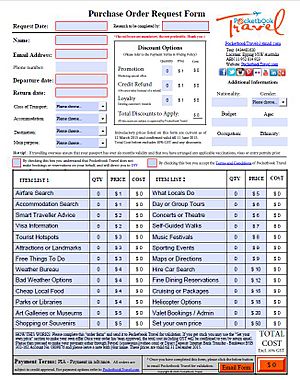Purchase order facts for kids
A purchase order (often called a PO) is like a special shopping list or a formal request that a buyer (someone who wants to buy something) sends to a seller (someone who sells things). It clearly states exactly what the buyer wants to buy, how much of it, and how much it will cost. When the seller agrees to the purchase order, it becomes a contract or a promise that both sides must keep. This means the seller has to provide the items, and the buyer has to pay for them.
Contents
What is a Purchase Order?
A purchase order is a document that officially shows a buyer's plan to buy goods or services from a seller. Think of it as a written agreement that helps both the buyer and the seller understand what is expected. It makes sure everyone is clear about the deal before anything is shipped or paid for.
Why are Purchase Orders Used?
Purchase orders are very important in business for several reasons:
- Clear Communication: They make sure there are no misunderstandings between the buyer and seller about what is being bought.
- Legal Protection: Once accepted, a PO becomes a legal agreement. This protects both sides if there's a problem later.
- Tracking and Budgeting: Businesses use POs to keep track of what they have ordered and how much money they are spending.
- Avoiding Duplicate Orders: They help prevent ordering the same thing twice by mistake.
What Information is on a Purchase Order?
A typical purchase order includes many important details to make sure the order is correct.
Key Details on a PO
- PO Number: A unique number for each order, like a tracking ID.
- Buyer's Information: The name and address of the company or person buying.
- Seller's Information: The name and address of the company selling the items.
- Date: When the purchase order was created.
- Item Description: A clear list of what is being bought (e.g., "blue pens," "laptop computers").
- Quantity: How many of each item is being ordered.
- Unit Price: The cost of one single item.
- Total Price: The total cost for all items, including any taxes or shipping fees.
- Delivery Date: When the buyer expects to receive the items.
- Shipping Address: Where the items should be sent.
- Payment Terms: How and when the buyer will pay (e.g., "payment due in 30 days").
How Does a Purchase Order Work?
The process of using a purchase order usually follows a few simple steps.
Steps in the PO Process
- Step 1: Buyer Creates PO: The buyer decides what they need and creates a purchase order with all the details.
- Step 2: PO Sent to Seller: The buyer sends the purchase order to the seller.
- Step 3: Seller Reviews and Accepts: The seller checks the PO. If they agree to the terms, they accept it. At this point, it becomes a binding contract.
- Step 4: Seller Delivers Goods: The seller then prepares and ships the items to the buyer.
- Step 5: Buyer Receives and Pays: Once the buyer receives the items and confirms they are correct, they make the payment according to the agreed terms.
Who Uses Purchase Orders?
Many different types of organizations use purchase orders, from small businesses to very large companies and even government agencies.
Examples of PO Users
- Businesses: Companies use POs to buy raw materials, office supplies, or equipment.
- Schools: Schools might use them to order textbooks, sports equipment, or classroom supplies.
- Hospitals: Hospitals use POs to purchase medical supplies, medicines, and equipment.
- Government Agencies: Governments use them for everything from building roads to buying office furniture.
Purchase orders are a key part of how businesses manage their buying and selling, making sure everything is clear, organized, and legally sound.
See also
 In Spanish: Orden de compra para niños
In Spanish: Orden de compra para niños


